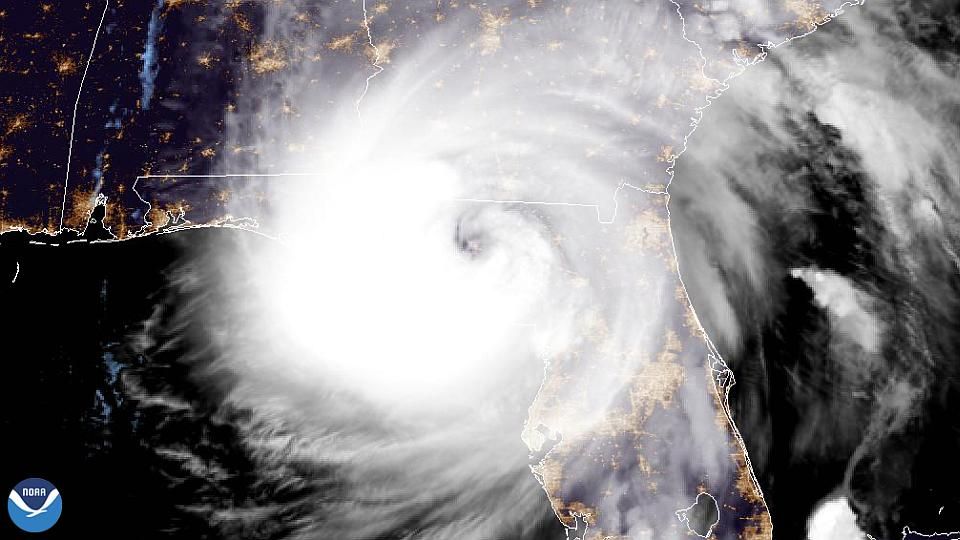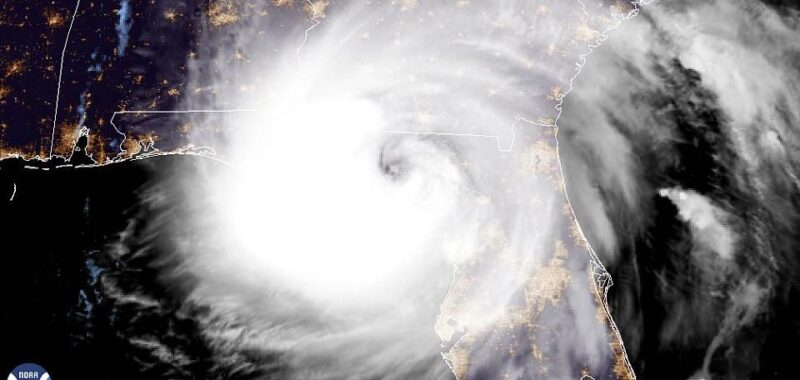
A satellite image of Hurricane Helene making landfall in Florida | National Oceanic and Atmospheric Administration (NOAA)
The majority of Hurricane Helene’s size and force dissolved over the weekend as it traveled up through Tennessee and Kentucky, seen from PBS live map coverage via National Oceanic and Atmospheric Administration (NOAA) data. However, it left behind countless devastation, with scores of power outages, flooded cities causing civilian displacements and deaths, and billions of dollars in damage in the Southeast states of Florida, Georgia, North Carolina, South Carolina, and Virginia.
The hurricane’s winds, rain, and floods damaged and destroyed numerous farming and greenhouse operations. How do these operations move forward, and what does it mean for the agriculture and horticulture industries at large for the foreseeable future?
Florida’s Preliminary Impact Report and Recovery Loan Program
The University of Florida Institute of Food and Agricultural Sciences (IFAS) Extension is conducting an agricultural assessment survey to calculate losses and damages from the storm. The UF/IFAS did similar work in the aftermath of Hurricane Debby, which struck in August 2024, compiling an Economic Impact Analysis Program (EIAP) report, which estimated the damages to be between $93.7 and $263.2 million.
The damage estimates for Hurricane Helene are likely to be much higher.
Meanwhile, in Florida, Commissioner of Agriculture Wilton Simpson announced that growers impacted by Hurricane Helene are able to apply for interest-free loans through the Agriculture and Aquaculture Producers Natural Disaster Recovery Program. These loans can be used by growers to restore, repair, and/or replace essential equipment, and to remove and dispose of debris.
Details on the application process, as well as recommended practices, can be found on the Florida Department of Agriculture and Consumer Services (FDACS) website.
Florida State Florists’ Donation Drives
For a floral industry focus, Details Flowers of Ormand Beach, FL, has reported on relief efforts started up by local Florida florists.
The Florida State Florist Association (FSFA) has coordinated donation drives and resource drop-off locations throughout the state for florists, growers, and supporters to contribute much-needed supplies to those most affected by Hurricane Helene.
Immense Damage to Georgia’s Growing Operations
Numerous businesses in the agriculture and horticulture spaces were affected by Hurricane Helene’s destructive path through Georgia. According to Matthew Agvest, Communications Director for the Department of Agriculture, who spoke with Bloomberg, almost every commodity was impacted, including cotton, pecans, poultry, and timber.
In contrast to Hurricane Debby’s impact on Florida in 2022, Georgia experienced Hurricane Michael in 2018, which reportedly caused $2.5 billion in agricultural damages. The state expects that the total in the aftermath of Hurricane Helene will be higher.
Georgia Agriculture Commissioner Tyler Harper, quoted by the Georgia Farm Bureau, says, “My message to farmers is document, document, document. “We need as much information as possible to ensure that we can get the needed resources, and the needed help deployed as quickly as possible. We’ve already started discussions with Georgia’s U.S. Congressional delegation to get federal disaster declaration and funding.”
Floods and Relief Efforts in the Carolinas
“Torrential rainfall from the remnants of Hurricane Helene capped off three days of extreme, unrelenting precipitation, which left catastrophic flooding and unimaginable damage in our Mountains and southern Foothills,” says the North Carolina State Climate Office.
Due to its relegation to the western half of North and South Carolina, the majority of the states’ agriculture and horticulture operations were unaffected. However, the storm’s presence in the Appalachia mountainous areas, full of high terrain and rivers, produced disaster flooding that spread far and wide, such as the calamity in Asheville, NC, one of the largest cities in the western half of the state that was underwater for several days.
Meanwhile, the Carolina Farm Stewardship Association (CFSA) and Clemson University have both rolled out resource information for affected operations as well as advising assessment and documentation measures to ensure proper funding is provided for recovery and rebuilding.
A Kentucky Florist’s Tree Fall and Greenhouse Damage
Damage to those in Kentucky has thankfully been minimal compared to its southern and eastern neighbors. However, the state has still been afflicted by heavy rains, high winds, and power outages.
Michler’s Florist in Lexington, KY, reported on by the Lexington Herald Leader, had its largest, on-site Hackberry tree blown down and landed atop two of its greenhouses.
USDA, FEMA, and Other Disaster-Relief Assistance Programs
The USDA, FEMA, and other disaster organizations have created the Disaster Resource Center. This portal allows users to search through an information database of disaster-related resources to help those affected by a natural disaster.
The Extension Disaster Education Network (EDEN), made possible by USDA support, has also updated its flooding resource packet in the wake of Hurricane Helene.
Additionally, the USDA has also developed the Disaster Assistance Discovery Tool for rural and agricultural issues. By answering five questions, the tool can direct growers toward the disaster assistance and relief programs best suited to helping them recover from this extreme weather event.
For any readers experiencing issues, damages, and/or losses in their operations because of the effects and aftermath of Hurricane Helene, we here at Greenhouse Grower would like to hear from you. Please comment below or reach out to Multimedia Specialist Nick Matysik at [email protected] to share your story.

